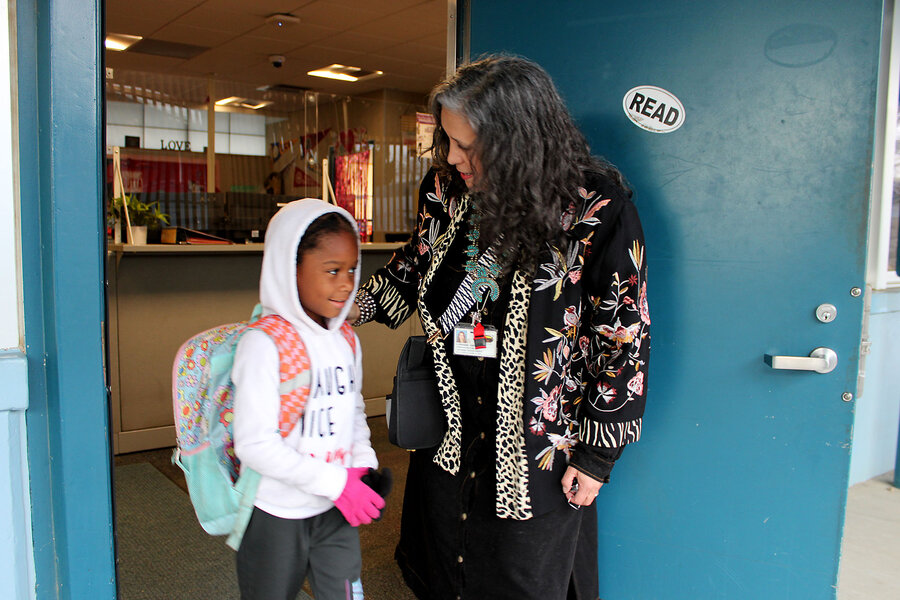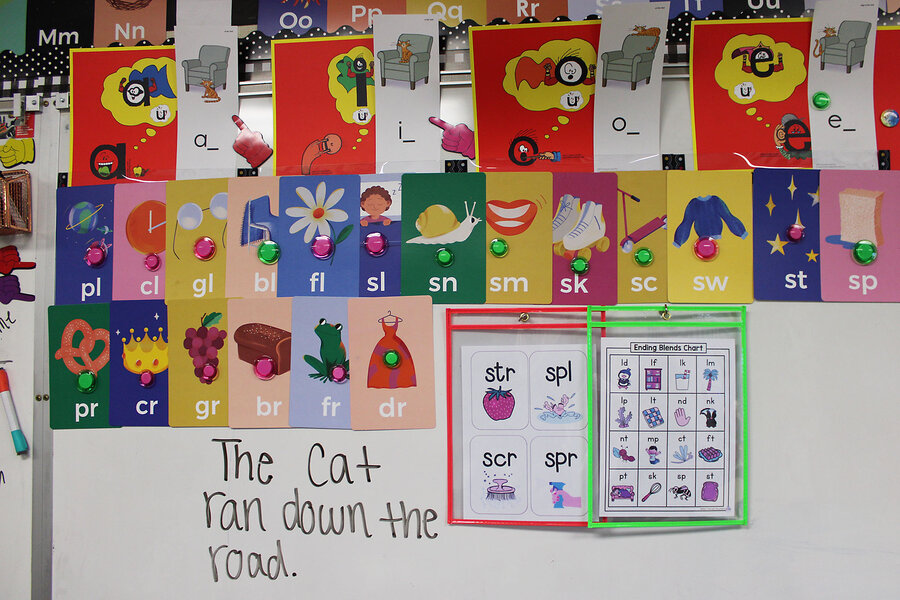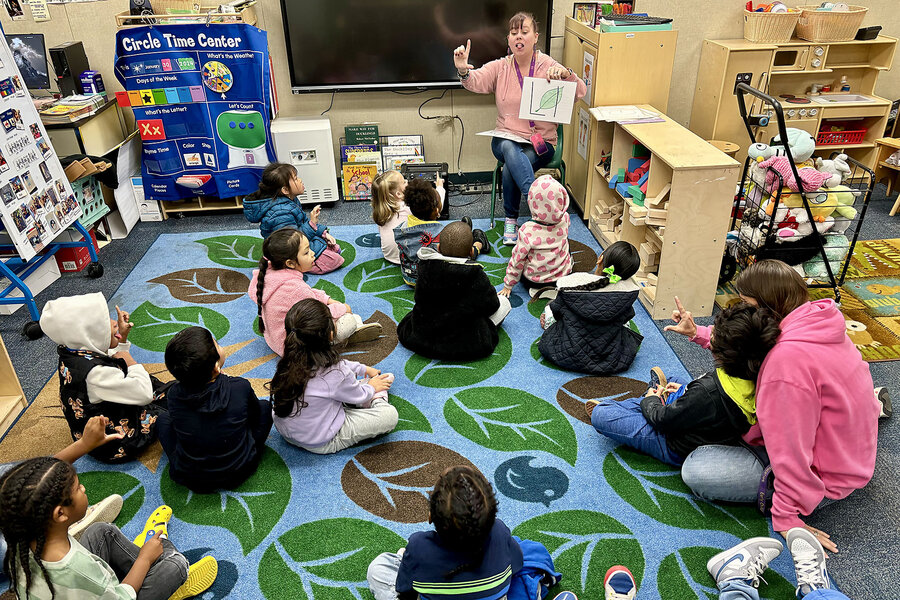Too many California kids can’t read. Phonics alone may not be the fix.
Loading...
| LANCASTER, CALIF.
Every minute counts in the quest to turn children into readers.
That’s why Joshua Elementary School’s principal, Lorraine Zapata, guards a door shortly after 8 a.m. She stops each student crossing the threshold and asks for a handshake.
Why We Wrote This
A story focused onStates are leaning into the “science of reading” to address a growing crisis in learning. But can the approach be effective if underlying issues like student hunger and absenteeism aren’t also addressed?
As Ms. Zapata uses her right hand for the formal greeting, her left thumb clicks a counting device. Each click represents a tardy student. By the day’s end, the number grows to 131 out of 500-some students. Their efforts to teach students how to read are in vain, she says, if the students aren’t there to learn.
She hurries them off to class, where reading instruction is about to begin. The school is among a growing number nationwide that have embraced a phonics-based “science of reading” teaching style at a critical time. Simply put, too many of America’s kids can’t read.
Ineffective teaching strategies, exacerbated by pandemic-era learning disruption, have snowballed into a generation of struggling readers. Not making changes, science of reading proponents warn, could have wide-reaching implications, for both children and society at large.
“What is that going to be in the future?” says Maryanne Wolf, a cognitive neuroscientist. “We’re going to have an electorate that has the lowest literacy level.”
Every minute counts in the quest to turn children into readers.
That’s why Joshua Elementary School’s principal, Lorraine Zapata, guards a door shortly after 8 a.m. She stops each student crossing the threshold and asks for a handshake.
As Ms. Zapata uses her right hand for the formal greeting, her left thumb clicks a counting device. Each click represents a tardy student. By day’s end, the number grows to 131 out of 500-some students. Their efforts to teach students how to read are in vain, she says, if the students aren’t there to learn.
Why We Wrote This
A story focused onStates are leaning into the “science of reading” to address a growing crisis in learning. But can the approach be effective if underlying issues like student hunger and absenteeism aren’t also addressed?
She hurries them off to class, where reading instruction is about to begin. The school is among a growing number nationwide that have embraced a phonics-based “science of reading” teaching style at a critical time. Simply put, too many of America’s kids can’t read.
Ineffective teaching strategies, exacerbated by pandemic-era learning disruption, have snowballed into a generation of struggling readers. Not making changes, science of reading proponents warn, could have wide-reaching implications, for both children and society at large.
“What is that going to be in the future?” says Maryanne Wolf, a cognitive neuroscientist and director of the Center for Dyslexia, Diverse Learners and Social Justice at the University of California, Los Angeles. “We’re going to have an electorate that has the lowest literacy level.”
Take California, for instance, where only 43% of third graders met or exceeded English language arts standards on a state test in 2023. And for third graders from low-income families, it’s even worse, with only 3 in 10 reading on grade level. By that point in school, as the education mantra goes, third graders should be reading to learn, not learning to read. The consequences of not catching up and falling further behind lead to this sobering reality: About 28% of adults in California are illiterate.
A widening coalition of literacy experts and cognitive neuroscientists believes the learning solution lies in the science of reading, which essentially hard-wires the brain to grasp fundamental concepts underlying language and reading. Sounds correspond to letters and letter combinations, which form words that have meaning.
In recent years, dozens of states and Washington, D.C., have passed laws aimed at overhauling how reading is taught – moving away from programs that de-emphasized phonics. California could become the next state to make the shift toward a mandated science of reading approach. If lawmakers approve recently proposed legislation, the state would update its instructional materials, require teacher training, and make changes to how aspiring educators are taught at the collegiate level.
“With an education, doors open and jobs happen,” Ms. Zapata says. “But if you are missing reading, you probably won’t even finish high school, which will put you below the poverty line and just getting by.”
She pauses to emphasize her final point: “That’s why reading is a civil right.”
“The priority of reading”
California’s science of reading bill – whose principal author, Assemblymember Blanca Rubio, is a former teacher – will receive its first legislative committee hearing in March.
Despite bipartisan support, the bill’s chances may come down to money. The Golden State is facing a roughly $38 billion shortfall this year. The professional development tied to the bill would cost an estimated $200 million to $300 million, says Marshall Tuck, CEO of EdVoice, a sponsor of the bill.
Even so, he frames the need as an equity issue, especially for children in low-income communities whose families cannot afford tutors or other reading boosts.
“A budget is a statement of priorities,” he says. “And we believe that this is not a lot of money when it comes to the priority of reading.”
The bill provision concerning teacher preparation programs has been lauded as a critical missing link. If colleges and universities graduate teachers armed with science of reading skills, that reduces the training burden at individual schools.
Moving away from “whole language”
Before the recent shift, many American public schools used an approach that is often described as “whole language” or “balanced literacy.” Joshua Elementary was one of those.
Though the strategies varied in practice, schools generally operated under the belief that if immersed in books and exciting stories, children would develop a love for literature and naturally pick up language patterns and reading. Some phonics instruction occurred. But educators also used cuing strategies such as asking students to determine words based on context clues or visuals.
On state standardized tests, the percentage of Joshua Elementary students meeting or exceeding grade-level benchmarks often registered in the single digits. The frustrating situation gnawed on staff’s confidence and morale. Looking back, Ms. Zapata describes literacy instruction as “haphazard.” Teachers asked students to look at a picture to help decipher words or think about the story plot.
But that changed several years ago when the school found itself plugged into a new literacy program. A 2017 lawsuit against California alleged the state was violating its constitutional responsibility of ensuring education by sending children to schools where they were not learning to read. The case settlement sparked the creation of a block grant program to support early literacy instruction.
Beginning in July 2021, the state enrolled roughly 70 of its lowest-performing elementary schools into the program. It came with an edict: Convert to a science of reading approach.
The program allowed the schools some discretion in how they spent grant money toward that purpose: instructional coaches, professional development, assessment tools, instructional materials, tutoring, after-school programming, and parent outreach, among others.
Joshua Elementary leaders, for instance, hired a literacy coach, who works directly with teachers. K-3 educators also received intensive training in the science of reading. That academic instrument, so to speak, is one that staff believes will strengthen learning throughout these predominantly Black and Latino students’ lives.
Parent Tanai Thedford, whose 6-year-old daughter and 4-year-old son attend the school, says she regularly sees evidence of reading gains. Just as importantly, she also sees enthusiasm.
“She’ll come and she will be like, ‘Put your choppers up, Mom. Let’s chop up this word,’” she says, referring to a hand motion they use to break words into syllables in her daughter’s class.
And her son is a sponge, she says, soaking up everything his big sister is doing. It gives her hope for their future.
“I could be looking at our future president, a future RN, a future doctor, astronaut,” she says. “Whatever they want to be.”
“Ham-bur-ger” and “spa-ghe-tti”
On a recent morning, a symphony of letter sounds drifts from classrooms as students and staff start their day.
In one room, a teacher leading 4-year-olds holds a sign featuring the letter J. She slowly and deliberately enunciates the corresponding sound. Her students follow suit. The decibel level rises as they gain confidence mastering the letter sound.
In a nearby kindergarten classroom, teacher Gretchen Shimer announces another iteration of phonemic awareness, or an understanding of speech sounds. “All right, friends, are we ready to blend?” she says. “Today, we are going to blend three sounds.”
And so begins a chorus of words with a theme that could make the youngsters’ bellies rumble: “ba-nan-a,” ”straw-berr-ies,” “ham-bur-ger,” and “spa-ghe-tti.”
Second grade teacher Emily Cooksey says the teaching approach has brought her students closer to grade-level reading skills. Fewer students entered her class this year needing beginner help known as “alphabet boot camp.”
A fringe benefit also emerged for Ms. Cooksey, who has dyslexia and never understood the phonics underlying word construction until she learned how to teach that way.
“It has made me a stronger reader even as an adult to look at some words and go, “Oh, that’s how you say that word,’” she says.
In December, two Stanford University researchers released a study showing the program “generated significant (and cost-effective) improvements” during its first two years.
On average, students attending the block grant-eligible schools gained nearly a quarter year of reading skills, outpacing their peers at similar schools, says Thomas Dee, the Barnett Family Professor at Stanford’s Graduate School of Education. The schools also saw some spillover gains in students’ math achievement.
“I’m hopeful that schools will be able to continue to nurture the reading gains and the math gains the students have achieved, and that it will redound to future success,” Dr. Dee says. “But we’re going to have to wait and see for time to pass and there’s data to become available.”
The schools’ initial success, offering proof of possibility, has intensified the drumbeat for more science of reading-based instruction. The recently proposed legislation, dubbed “California Kids Read,” sets a multiyear pathway for moving the state wholly in that direction.
Dr. Wolf, the UCLA cognitive neuroscientist, has been urging people to think of it as more than just phonics. Done correctly, she says, the teaching method creates deep readers capable of not only decoding words but also mastering their meaning and usage.
When that happens, the written words in a book activate feelings and critical thinking that children need as they grow.
“These stories teach empathy,” she says. “They teach having friendships that are different from you. They teach about perspective-taking.”
Before reading, meeting basic needs
Ms. Zapata knows this all too well at her school, where the challenges are many and staff turnover is high. A large portion of children come to school carrying trauma from home lives disrupted by addiction, abuse and neglect, incarceration, homelessness, chronic illnesses, and hunger. The school is their safe haven from a neighborhood that tilts toward instability. On a weekday in January, suspects opened fire from a sidewalk bordering the school and shot multiple rounds toward a nearby house. The school building went into lockdown.
The school provides meals, a clothing closet, and virtual doctor appointments for students.
“That’s the reality of the neighborhood we’re in,” Ms. Zapata says. “And so how do you help students regulate? How do you help families regulate? And how do you help the professionals that are here regulate to do the important work?”
Her response to the proposed legislation: “Hallelujah.”
In essence, more trained educators should lead to more consistency over time. It’s a similar struggle with students. Of the 120-plus kindergartners at Joshua Elementary when this work began, only 53 remain today.
Ms. Zapata says the school relies on constant assessments of new and existing students to measure their reading growth. School-based diagnostic tests have shown greater numbers of students at or approaching grade-level reading skills.
Moving the needle on state standardized tests has been more difficult. Nine percent of the school’s students met or exceeded state literacy standards during the 2022-2023 academic year, a modest 1 percentage point increase over the prior year.
It’s nowhere near where the school needs to be, Ms. Zapata says. As the school chugs full steam ahead with the science of reading, she believes that will change when today’s younger students start taking those tests.
To curb tardiness and chronic absenteeism, Ms. Zapata has been making home visits. She recently purchased snacks as a goodwill offering. With goodies in hand, she learns more about her students and encourages them to show up each day to learn.
“[The science of reading] is not a magic panacea,” she says. “It’s consistency and building the pathways in the brain and then making sure that our kids are here and engaging – in spite of whatever trauma, in spite of whatever they bring with them.”












